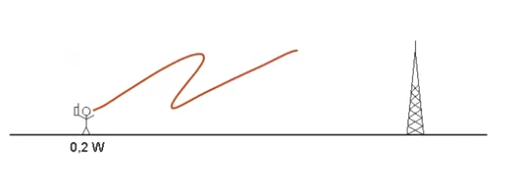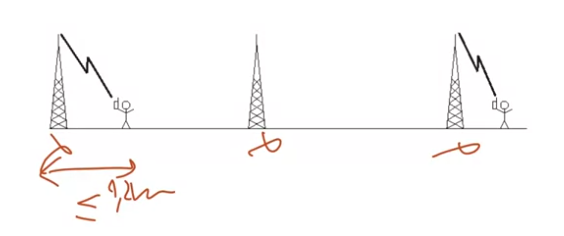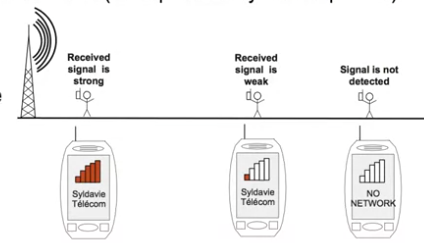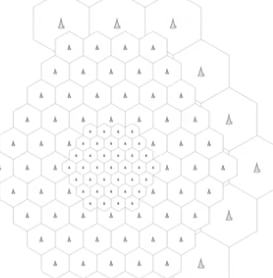The Need to Cover The Entire Territory with Base Stations
- The transmission power of a UE (user equipment) is typically 0.2 W or 200 mW.
- The maximum range is typically several kilometers for a signal of this strength

- The operator deploys base stations on the territory to be covered so that a terminal is always less than a few kilometers away from a base station
- In practice, it’s not always true,
- how do we know we have network access?

The transmission power of a terminal or a UE in the 4G vocabulary is typically 0.2 watt, or 200 milliwatts. The range with such power obviously depends on the situation. In other words, if I am in the city, it’s not the same range as if am in the country, but we can give, as an order of magnitude, a maximum range of several kilometers for a strength of 0.2 watts. That means if I’m very far from the base station antenna, I’m not going to be able to have my communication, my access to mobile Internet.
What the operator will do, is deploy base stations as regularly as possible in order to cover the territory in a way that, wherever I am, I am less than a few kilometers from a base station. Of course, in practice, this isn’t true, there are white areas where there is no coverage, but having base stations everywhere is the ultimate objective.
Now the question is, how to know if I have access to the network, whether I actually am close enough to a base station to have access to mobile internet. For that, each base station periodically broadcasts a signal called the beacon channel. This beacon channel first enables indication of the presence of the network and it gives the characteristics of the network, among which the identity of the operator. This way, my terminal will try to listen for my operator’s base station and not that of the competitor.
General Principle of the Beacon Channel
- Each base station broadcasts a signal reguraly
- Which indicate its existence
- Which gives the characteristics of the network (example: identity of the operator)
- Concept of the beacon channel (broadcast control channel)
- By measuring the strength of the signal received, each terminal can indicate if it receives the base station well or not

All terminals measure the strength with which they receive this beacon channel. We’ve made a simple example on the drawing: the transmission of the beacon channel is symbolized by these concentric arcs. When the person is close to the base station, the signal received is very strong, this corresponds to having a lot of bars on the terminal’s display. The further you are from the base station, the fewer bars you have. When the terminal doesn’t detect any signal, well, then it displays the message, “No network,” and, logically, there aren’t any bars.
The Case of a Rural Zone and a Suburban Zone
Let’s get back to the grid of base stations over the territory. Here we have an example around Rennes (cartoradio.fr). The scale is 5 kilometers. When there’s a 1, that means that there is one base station and we can see that the base stations are relatively regularly placed to provide coverage. If we look at an area around Rennes – Rennes is about here –we see that, in the area surrounding Rennes, the base stations are a little more densely arranged than in the previous case. And if we look at the downtown, it’s the following slide, we have Rennes. The scale is 2 kilometers. Base stations are densely arranged and when we have the number 2, that means there are two base stations not too far away. What does that mean? That means that the operator, when it has a lot of customers to serve, will deploy a large number of base stations. And the area covered by a base station, called a cell, is smaller.
Capacity and Coverage
- Dividing the territory up into cells
- each cell is served by base station
- the division into cells is not perceptible to the user – passing from one cell to another cell is, ideally, imperceptible.
- the capacity of a cell in Mbit/s does not depend on the size of the cell
- Urban zone = high user density
- the base stations are deployed to provide sufficient capacity
- deploy enough base station so that the capacity in Mbit/s per km2 is superior to the traffic created by the customers
- Rural zone = low user density
- the base stations are deployed to ensure coverage
- deploy enough base station so that, at every point of the territory, a terminal is under the range of a base station and can connect.

In the suburban zone, it will be a little larger and in the rural zone, it will be much larger, from several kilometers up to a radius of ten kilometers. The concept of cells consists of dividing the territory into “cells”, each one served by one base station. For people who access the network, their terminal transmits to the base station and that signal is then sent into the network. Ideally, the division into cells is imperceptible to the user; that’s the objective. Passing from one cell to another, when the user moves, should be completely invisible.
What we could show with a small mathematical model is that the capacity of a cell, that is, the number of megabits per second that one can transmit by cell does not depend on the size of the cell. In the urban area, there’s a high density of users. In this case, the base stations are deployed much more densely, because there’s a problem of capacity:
- the operator should deploy enough base stations so that the capacity in Mbit/s per km2 is superior to the traffic created by the customers.
- In rural areas, there’s low density of users, so the operator will try to just ensure coverage. The operator should deploy enough base stations so that, at every point of the territory, a terminal is under the range of a base station and can connect.
Question
- A cellular network is made of
- a set of base stations deployed accross a large territory and connected to a fixed network
- In a zone that is densely populated (tick two boxes),
- cells are small to provide a high capacity in Mbit/s/km2
- cells are small to minimize transmit powers
- In a mobile network, the territory is divided into cells to (tick two boxes)
- make sure a terminal is always in range of base station
- increase the capacity of the network
- The beacon channel is
- transmitted by the base station and is used by the terminal to get an indication of the level coverage.
- Consider a terminal that does not detect any beacon channel. It means that:
- no cellular network covers the area where the user is located